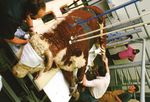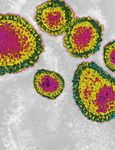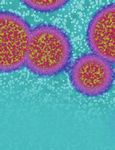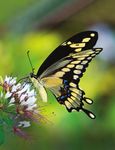Case Report Late Onset of Cerebellar Abiotrophy in a Boxer Dog
←
→
Page content transcription
If your browser does not render page correctly, please read the page content below
SAGE-Hindawi Access to Research
Veterinary Medicine International
Volume 2010, Article ID 406275, 4 pages
doi:10.4061/2010/406275
Case Report
Late Onset of Cerebellar Abiotrophy in
a Boxer Dog
Sanjeev Gumber, Doo-Youn Cho, and Timothy W. Morgan
Department of Pathobiological Sciences, School of Veterinary Medicine, Louisiana State University, Skip Bertman Drive,
Baton Rouge, LA 70803, USA
Correspondence should be addressed to Sanjeev Gumber, sgumber@vetmed.lsu.edu
Received 2 August 2010; Accepted 7 November 2010
Academic Editor: Daniel Smeak
Copyright © 2010 Sanjeev Gumber et al. This is an open access article distributed under the Creative Commons Attribution
License, which permits unrestricted use, distribution, and reproduction in any medium, provided the original work is properly
cited.
Cerebellar abiotrophy is a degenerative disorder of the central nervous system and has been reported in humans and animals. This
case report documents clinical, histopathological, and immunohistochemical findings of cerebellar abiotrophy in an adult Boxer
dog. A 3.5-year-old, female, tan Boxer dog presented with a six-week history of left-sided head tilt. Neurological examination
and additional diagnostics during her three subsequent visits over 4.5 months revealed worsening of neurological signs including
marked head pressing, severe proprioceptive deficits in all the four limbs, loss of menace response and palpebral reflex in the left
eye, and a gradual seizure lasting one hour at her last visit. Based on the immunohistochemical staining for glial fibrillary acidic
protein and histopathological examination of cerebellum, cerebellar cortical abiotrophy was diagnosed. This is the first reported
case of cerebellar abiotrophy in a Boxer dog to our knowledge.
1. Introduction 2. Case History
Cerebellar abiotrophy is a term used to describe premature A 3.5-year-old, intact female tan Boxer was referred to
degeneration of fully formed cerebellar neurons caused by veterinary teaching hospital and clinic for a six-weeks history
an intrinsic metabolic defect [1]. Cerebellar abiotrophy has of left-sided head tilt. On physical examination, the dog had
been described in dogs, cats, sheep, cattle, pigs, horses significant left head tilt, circling to the right, ataxia, and
[2], and alpaca [3]. Canine cerebellar abiotrophy was first mild ventral strabismus in the left eye. Intracranial disease
reported in the Kerry blue terrier and has since been was suspected, but the possibility of middle ear infection
characterized as an autosomal recessive inherited disorder in was not completely excluded. A complete blood cell count
that breed [1]. Cerebellar abiotrophy differs from cerebellar (CBC), serum biochemical panel, computed tomography
hypoplasia, which involves abnormal development of ger- (CT), and cerebrospinal fluid (CSF) analysis were performed.
minal populations of neuroepithelial cells [1, 2]. Clinically, Results of the CBC and serum biochemical panel were
animals with cerebellar abiotrophy are normal at birth and within reference intervals. CT scan of the brain revealed
develop progressive neurological deficits during the post- mild bilateral hydrocephalus, which was considered to be
natal period. Histologically, cerebellar abiotrophies typically an incidental finding or associated with a space occupying
involve a primary degeneration or loss of Purkinje neurons, lesion in the brainstem. Therefore, a complete examination
variable loss of granule cells, and cortical astrogliosis [4]. of the brainstem with magnetic resonance imaging (MRI)
The following case describes clinical, histopathological and was indicated. The owner declined MRI at that time. The dog
immunohistochemical features of a putative case of cerebel- had chronic otitis externa, and the middle ear canals were
lar abiotrophy in a 3.5-year-old Boxer dog. within normal limits. CSF analysis revealed 27 nucleated2 Veterinary Medicine International
W IG M
(a) (b)
EG
EG
M
M
IG
W
(c) (d)
Figure 1: Cerebellum, dog. (a) Multifocal thinning of the cerebellar folia. Hematoxylin and eosin stain (HE). Bar: 1 mm. (b) Moderate
hypocellularity of the inner granular layer (IG), increased cellularity in the white matter (W), and a well-defined molecular layer (M).
HE stain. Bar: 500 µm. (c) Moderate, multifocal depletion and degeneration of purkinje cells (arrow) and partial retention of the external
granular layer (EG). HE stain. Bar: 200 µm. (d) Marked astrogliosis evidenced by positive GFAP immunostaining in the external granular
layer (EG), molecular layer (M), inner granular layer (IG), and white matter (W). Immunoperoxidase with 3-, 3 -diaminobenzidine with
Mayer’s hematoxylin counterstain. Bar: 1 mm.
cells/µL (reference interval:Veterinary Medicine International 3
the external granular layer (Figure 1(c)). A marked increase Histologically, there was a partial impairment of cerebel-
in cellularity (astrogliosis) was present in the white matter, lar granule cell migration along with cerebellar abiotrophy in
which was confirmed immunohistochemically. The sections the present case. In the developing central nervous system,
of spinal cord had mild, multifocal axonal degeneration. The immature cerebellar granule cells migrate from the external
histopathological findings were consistent with cerebellar germinal layer through the molecular layer to form the inner
abiotrophy. granule cell layer [22]. Cortical granule cells that do not
Immunohistochemical staining of formalin-fixed, paraf- migrate to the inner granule layer typically fail to mature
fin-embedded sections was performed as described by the properly. Deficits in neuronal migration have been reported
manufacturer using glial fibrillary acidic protein (GFAP) in humans following genetic mutation and exposure to
rabbit polyclonal antibody (Code number Z0334) and environmental toxins. However, the exact pathophysiology
myelin basic protein (MBP) rabbit polyclonal antibody of these cortical abnormalities is still unclear [23]. The likely
(Code number 18-0038, EnVision+ System-HRP Labeled cause of impaired neuronal migration in this case could be a
Polymer (DAB), Dako North America Inc., Carpinteria, CA.) genetic mutation.
The positive control tissue was a section of a cerebellum MRI findings are normal during early stages of cerebellar
from an unaffected dog. The negative control tissue con- abiotrophies, but late stages of chronic abiotrophy reveal
sisted of the same system without the primary monoclonal atrophy of the cerebellar folia [4]. MRI might have detected
antibody. Immunohistochemical staining for GFAP revealed the cerebellar abiotrophy in the present case; however, the
marked astrogliosis in the molecular and granular layers, owner declined further diagnostics at the initial visit. MRI
white matter, and partially retained external granular layer has been used successfully for the diagnosis of cerebellar
(Figure 1(d)). MBP immunostaining showed no significant cortical degeneration in a Scottish terrier [13]. Reduction
changes in the arborization of the fibers in the white of cerebellar size has been identified in several reports of
matter. Marked astrogliosis on GFAP immunostaining fur- cerebellar abiotrophies [11, 24, 25]. No gross changes were
ther supported the histopathological diagnosis of cerebellar detected in the cerebellum during postmortem examination
abiotrophy. in this dog although the clinical history was compatible with
chronic progression of cerebellar abiotrophy. The absence
of gross changes could be due to breed predisposition;
3. Discussion however, a specific cause remains undetermined. To the
authors’ knowledge, this is the first reported case of cerebellar
Cerebellar abiotrophy has been identified in many breeds of abiotrophy in a Boxer dog. Additional cases and further
dogs including rough-coated collie [5], Border collies [6], research are required to prove heritability in this breed
Australian kelpie [7], Labrador retrievers [8], Bernese moun- although the authors were unable to completely determine
tain [9], Rhodesian ridgebacks [10], Portuguese podencos the pure-bred status of the animal.
[11], Miniature Schnauzer [12], Scottish terrier [13], Beagle
[14], English bulldog [15], and Lagotto Romagnolo [16]. The
age of onset and progression of clinical signs of cerebellar References
dysfunction vary markedly according to the breed affected.
The clinical signs associated with abiotrophic diseases are [1] A. de Lahunta, “Abiotrophy in domestic animals: a review,”
usually seen within first weeks or months of life and involve Canadian Journal of Veterinary Research, vol. 54, no. 1, pp. 65–
the cerebellar cortex [2]. Gordon setters [17] and Brittany 76, 1990.
spaniels [18] have been identified with onset of clinical signs [2] B. A. Summers, J. F. Cummings, and A. De Lahunta, “Degen-
from 6 to 30 months and 7 to 13 years of age, respectively. A erative diseases of the central nervous system,” in Veterinary
similar late onset of disease was observed in the present case. Neuropathology, B. A. Summers, J. F. Cummings, and A. De
Additionally, this disease has not been reported in a Boxer Lahunta, Eds., pp. 300–305, Mosby-Year Book, St. Louis, Mo,
USA, 1995.
dog previously.
[3] P. Mouser, M. Lévy, J. E. Sojka, and J. A. Ramos-Vara,
The cause of cerebellar abiotrophy is currently unknown, “Cerebellar abiotrophy in an alpaca (Lama pacos),” Veterinary
but it is presumed to be an inherited genetic abnormality. It Pathology, vol. 46, no. 6, pp. 1133–1137, 2009.
is thought to involve the excitotoxic degeneration of neurons [4] A. De Lahunta and E. Glass, “Cerebellum,” in Veterinary
containing glutamate receptors [1, 4]. A possible role of Neuroanatomy and Clinical Neurology, A. De Lahunta and E.
channelopathies with abnormal structure and function of Glass, Eds., pp. 343–388, Elsevier, St. Louis, Mo, USA, 2009.
voltage-gated calcium channels [19] and autoantibody- [5] W. J. Hartley, J. S. F. Barker, R. A. Wanner, and B. R. Farrow,
mediated disorders in humans has been suggested [20]. “Inherited cerebellar degneration in the rough coated collie,”
Canine herpesvirus has a predilection for the germinal layers Australian Veterinary Practitioner, vol. 8, pp. 79–85, 1978.
[6] J. M. Gill and M. Hewland, “Cerebellar degeneration in the
of the cerebellum in puppies. Puppies that survive canine
Border Collie,” New Zealand Veterinary Journal, vol. 28, no. 8,
herpes virus infection have reduced number of cells in p. 170, 1980.
the granular layer and mild loss of Purkinje cells. These [7] J. B. Thomas and D. Robertson, “Hereditary cerebellar
changes are consistently accompanied by foci of microgliosis, abiotrophy in Australian kelpie dogs,” Australian Veterinary
mononuclear cell infiltration, malacia and, mineralization Journal, vol. 66, no. 9, pp. 301–302, 1989.
[2, 21]. Such changes were not identified microscopically or [8] A. L. Perille, K. Baer, R. J. Joseph, J. M. Carrillo, and D. R.
with ancillary diagnostic tests in the current case. Averill, “Postnatal cerebellar cortical degeneration in Labrador4 Veterinary Medicine International
Retriever puppies,” The Canadian Veterinary Journal, vol. 32,
pp. 619–621, 1991.
[9] K. P. Carmichael, M. Miller, C. A. Rawlings, A. Fischer,
J. E. Oliver, and B. E. Miller, “Clinical, hematologic, and
biochemical features of a syndrome in Bernese Mountain Dogs
characterized by hepatocerebellar degeneration,” Journal of the
American Veterinary Medical Association, vol. 208, no. 8, pp.
1277–1279, 1996.
[10] C. Chieffo, I. H. Stalis, T. J. Van Winkle, M. E. Haskins, and
D. F. Patterson, “Cerebellar Purkinje’s cell degeneration and
coat color dilution in a family of Rhodesian Ridgeback dogs,”
Journal of Veterinary Internal Medicine, vol. 8, no. 2, pp. 112–
116, 1994.
[11] S. E. Van Tongeren, I. K. Van Vonderen, J. J. Van Nes, and T. S.
G. A. M. Van Den Ingh, “Cerebellar cortical abiotrophy in two
Portuguese Podenco littermates,” Veterinary Quarterly, vol. 22,
no. 3, pp. 172–174, 2000.
[12] M. L. Berry and U. Blas-Machodo, “Cerebellar abiotrophy in
a miniature schnauzer,” Canadian Veterinary Journal, vol. 44,
no. 8, pp. 657–659, 2003.
[13] L. L. Van Der Merwe and E. Lane, “Diagnosis of cerebellar
cortical degeneration in a Scottish terrier using magnetic
resonance imaging,” Journal of Small Animal Practice, vol. 42,
no. 8, pp. 409–412, 2001.
[14] M. Kent, E. Glass, and A. Delahunta, “Cerebellar cortical
abiotrophy in a beagle,” Journal of Small Animal Practice, vol.
41, no. 7, pp. 321–323, 2000.
[15] G. Gandini, C. Botteron, E. Brini, R. Fatzer, A. Diana, and
A. Jaggy, “Cerebellar cortical degeneration in three English
bulldogs: clinical and neuropathological findings,” Journal of
Small Animal Practice, vol. 46, no. 6, pp. 291–294, 2005.
[16] T. S. Jokinen, C. Rusbridge, F. Steffen et al., “Cerebellar cortical
abiotrophy in Lagotto Romagnolo dogs,” Journal of Small
Animal Practice, vol. 48, no. 8, pp. 470–473, 2007.
[17] A. Da Lahunta, W. R. Fenner, and R. J. Indrieri, “Hereditary
cerebellar cortical abiotrophy in the Gordon Setter,” Journal of
the American Veterinary Medical Association, vol. 177, no. 6,
pp. 538–541, 1980.
[18] L. M. Tatalick, S. L. Marks, and T. V. Baszler, “Cerebellar
abiotrophy characterized by granular cell loss in a Brittany,”
Veterinary Pathology, vol. 30, no. 4, pp. 385–388, 1993.
[19] M. Frontali, “Spinocerebellar ataxia type 6: channelopathy or
glutamine repeat disorder?” Brain Research Bulletin, vol. 56,
no. 3-4, pp. 227–231, 2001.
[20] B. Lang, R. C. Dale, and A. Vincent, “New autoantibody
mediated disorders of the central nervous system,” Current
Opinion in Neurology, vol. 16, no. 3, pp. 351–357, 2003.
[21] D. H. Percy, L. E. Carmichael, D. M. Albert, J. M. King, and A.
M. Jonas, “Lesions in puppies surviving infection with canine
herpesvirus,” Veterinary Pathology, vol. 8, no. 1, pp. 37–53,
1971.
[22] J. D. Mancini, D. M. Autio, and W. D. Atchison, “Continuous
exposure to low concentrations of methylmercury impairs
cerebellar granule cell migration in organotypic slice culture,”
NeuroToxicology, vol. 30, no. 2, pp. 203–208, 2009.
[23] H. Komuro and E. Yacubova, “Recent advances in cerebellar
granule cell migration,” Cellular and Molecular Life Sciences,
vol. 60, no. 6, pp. 1084–1098, 2003.
[24] M. Yasuba, K. Okimoto, M. Iida, and C. Itakura, “Cerebellar
cortical degeneration in beagle dogs,” Veterinary Pathology,
vol. 25, no. 4, pp. 315–317, 1988.
[25] R. J. Bildfell, S. K. Mitchell, and A. de Lahunta, “Cerebellar
cortical degeneration in a Labrador retriever,” The Canadian
Veterinary Journal, vol. 36, no. 9, pp. 570–572, 1995.International Journal of International Journal of
Agronomy Ecology
Veterinary Medicine The Scientific
Hindawi Publishing Corporation
Scientifica
Hindawi Publishing Corporation
International
Hindawi Publishing Corporation
World Journal
Hindawi Publishing Corporation Hindawi Publishing Corporation
http://www.hindawi.com Volume 2014 http://www.hindawi.com Volume 2014 http://www.hindawi.com Volume 2014 http://www.hindawi.com Volume 2014 http://www.hindawi.com Volume 2014
International Journal of Journal of
Microbiology
Hindawi Publishing Corporation
Viruses
Hindawi Publishing Corporation
http://www.hindawi.com Volume 2014 http://www.hindawi.com Volume 2014
Submit your manuscripts at
http://www.hindawi.com
Biotechnology
Research International
Hindawi Publishing Corporation
http://www.hindawi.com Volume 2014
Psyche
Hindawi Publishing Corporation
http://www.hindawi.com Volume 2014
Journal of Journal of
Insects Veterinary Medicine
Zoology
International Journal of
Case Reports in International Journal of
Veterinary Medicine Evolutionary Biology
Hindawi Publishing Corporation Hindawi Publishing Corporation Hindawi Publishing Corporation Hindawi Publishing Corporation Hindawi Publishing Corporation
http://www.hindawi.com Volume 2014 http://www.hindawi.com Volume 2014 http://www.hindawi.com Volume 2014 http://www.hindawi.com Volume 2014 http://www.hindawi.com Volume 2014
Applied &
International Journal of International Journal of Journal of Journal of Environmental
Genomics
Hindawi Publishing Corporation
Cell Biology
Hindawi Publishing Corporation
Parasitology Research
Hindawi Publishing Corporation
Animals
Hindawi Publishing Corporation
Soil Science
Hindawi Publishing Corporation Volume 2014
http://www.hindawi.com Volume 2014 http://www.hindawi.com Volume 2014 http://www.hindawi.com Volume 2014 http://www.hindawi.com Volume 2014 http://www.hindawi.comYou can also read



























































